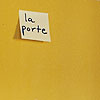




|
In her photographs, Elina Brotherus (born 1972) examines the
topologies of people and places; in these images of France,
she describes what it is like to live in a country whose language
one has not yet learned. Photographs and extracts from an
interview with Jan Kaila from Decisive days. Valokuvia.
Photographies. Photographs 1997–2001; graphic design
Minna Luoma. Pohjoinen, 2002)
When I began studying photographic art in
1995, I was still in the middle of my university science studies.
I was strongly resistant to investigating my own emotional life.
When I finally finished my master’s dissertation in chemistry,
I guess I was able to give up the scientific-analytical thinking
required by that type of work and to concentrate on intuition and
looking. This brought about a tremendous burst of creativity in
me, especially since I suddenly had some free time, and it is that
period that the first works that ended up in exhibitions come from.
A lot of old issues came to the surface and I began digging into
my own head, my own history.
I made Wedding Portraits (1997)
when I got married, Divorce Portrait (1998) when I got divorced,
and I hate sex (1998) when I felt that way. So I wasn’t
showing various women’s roles, but living my life and trying
to capture something genuine and real about it in the pictures.
A crucial factor was a sensitivity for recognising ‘decisive
moments’ and then to react quickly. The camera had to be easily
accessible, often I already had it read on a tripod in the corner
of the room. I did make my pictures ‘for the camera’ too,
but the more unforced the photographing became, the more the presence
of the camera could be ignored.
I at least hoped that the pictures
would rise above the personal level to become universal – over-intimate
revelatory art is a bit unpleasant. That’s why I tried to keep
the language ascetic and subdued: I didn’t want the pictures
to scream, ‘Look, I’m unhappy, have pity on me!’
In retrospect, I have actually noticed that I reached for the camera
more readily when I was unhappy. I worked the pain into a beautiful
object that could be looked at detached from myself, and this consoled
me a little. In a way it’s banal, but it is as if art legitimates
grief. I think in this way a lot of artists make indecent use of
their own unhappy lives as material for their art.
And then; I’m in no way special,
the same things have happened in my life as in everyone else’s:
people fall in love and split up, their mothers die. These are archetypal
events, and that is why people are able to recognise them, perhaps
to identify with them, even if the examples are taken from my own
life.
I try to avoid mannerisms. A work
has to have a certain coherence, but at the same time sufficient
variety so that things stay interesting. One thing that appeals
to me is the musical form ‘theme and variations’.
This is quite a common structural
solution; the composer composes or takes some already existing theme
and makes variations on it. The sonata form also has a main theme
and a subsidiary theme, which are played first, then comes the development,
in which the themes are varied, and in the final recapitulation
the themes are reiterated, slightly transformed, but almost the
same as in the beginning.
I think ‘theme and variations’
is also an excellent form for serial pictorial work. But have to
be careful that the whole thing doesn't become monotonous. I once
made the mistake of constructing an exhibition almost solely out
of self-portraits. It created a claustrophobic feeling: wherever
I looked, I was staring into my own eyes. After that, I started
making landscapes part of my exhibitions, alongside the self-portraits
– like commas, or breathing spaces, or windows, so that the
viewer would get to rest now and then....
Suites françaises 2 (1999) has an autobiographical
background, but the series’ primary content, with its questions
about understanding language, is something else. I see Suites
françaises 2 as a transition between the old and the
new work. The fact that I have photographed, for example, in France
and Iceland is, of course, a narrative elment, ‘EB was here’,
but I haven’t in any way tried to emphasise the place or to
give it significance on the basis of geographical location. Instead,
I have been interested in pictorial elements, purely on the basis
of visual perception. It has been a relief, something new and fresh.
Now that I have been happier, I have been able to concentrate on
observing my environment instead of myself.
If we think of the strongly personal-historical
material of the initial phase and my work at the moment, from which
autobiographical ingredients have been almost totally eliminated,
Suites françaises 2 is situated pretty well half-way
between. The starting point for the series was certainly my personal
situation, when I came to live in France with almost no grasp of
the language. But very many people share these experiences with
me: being an outsider, terrible loneliness, and the way that everyday
communication is difficult, never mind any deeper exchange of ideas.
As a survival strategy people try
to bring order to the conceptual chaos by naming things and through
that taking control of their environment and their life. In my case,
it was a question of taking of control – taking photographs
is also, like naming things, a way of taking control of the world....
In fact, it has worked out that since
the autumn on 1999 I have spent the greater part of my time in France.
Original photographs from Suites françaises 2, 1999
Inquiries / Decisive days: elina.brotherus@iki.fi
Top of page
|






